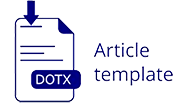Author Guidelines
Author Guidelines
Edulingua: Jurnal Linguistiks Terapan dan Pendidikan Bahasa Inggris
- A. General Requirements
- Manuscripts submitted to Edulingua: Jurnal Linguistiks Terapan dan Pendidikan bahasa Inggris should be research-based papers which have not been published or are under consideration elsewhere.
- Manuscripts must be in English. It should be typed in MS Word doc. format; using 12-pt Times New Rowman font; left, right, top, and bottom margins are 3 cm; single-spaced on A4-sized paper; 12-20 pages in length or 5000-6000 words.
- The manuscript will be reviewed by subject reviewers, while the editors reserve the right to edit the manuscript for format consistency without altering the substance.
- Make sure that the manuscript is prepared using the Edulingua Article Template.
- The manuscript must be sent through Edulingua website (OJS). Use the online submission guidelines for online submission.
- For confirmation, the Submission Checklist and Statement of Originality must be emailed to the Journal Editor (edulingu@unisnu.ac.id)
- The citations and references should follow the style of the American Psychological Association (APA) 6th Edition and use Reference Management Software Mendeley (http://www.mendeley.org).
- The Copyright Transfer Agreement Form must be emailed to the Journal Editor (edulingu@unisnu.ac.id) after the manuscript is accepted for publication.
B. Structure of the Manuscript
- The article structure contains: (a) Title; (b) Author(s) Name and Affiliation; (c) Abstract; (d) Keywords; (e) Introduction WITHOUT heading; (f) Method; (g) Findings; (h) Discussion; (i) Conclusion (and Suggestion); (j) References; and (k) Appendix, if any.
- Title. The paper title must be concise and informative. It should be pinpoint with the issue discussed. It does not contain infrequently-used abbreviations. The main idea should be firstly written and followed by its explanation. The title of the paper should not exceed 12 words, bold, centered, with 13-pt Palatino Linotype.
- Author(s) Name and Affiliation. Full name of contributor(s) must be written without academic title(s). The affiliation and complete affiliation address (including street, city, and country) should be written below the name. The email address of the author(s) should be written below the affiliation address. The author’s name(s) should be in 12-pt Times new Roman, and the affiliation, affiliation address, and email should be in 11-pt Times New Roman (name should be in bold; affiliation address should be in italic).
- Abstract. The abstract should be clear and informative. The abstract should succinctly describe your entire paper. It contains the purpose, methodology, and findings of the research. The abstract should stand alone, means that no citation or no references in the abstract. The abstract should tell the prospective reader what you did and highlight the key findings. Avoid using technical jargon and uncommon abbreviations. The abstract should be in one paragraph, not exceeding 200 words, in 12-pt Times New Roman, and with single space. It must appear on the top of the first page after the title of the paper, the name of the author, the author’s email, the author’s affiliation, and the affiliation address.
- Keywords. Keywords are the labels of your manuscript and critical to correct indexing and searching. Therefore, keywords should be well selected and closely related to the topic to facilitate the reader’s search, and they should represent the content and highlight of your article. Use only those abbreviations that are firmly established in the field. There must be 3-5 keywords (word or phrase). Each word or phrase in Keywords should be separated by a semicolon (;), not a comma (,).
- Introduction. Introduction of the paper should be written without heading. An introduction should clearly state the purpose of the paper. It includes a review of related literature and research purpose in essay style. The introduction should include key references to appropriate work. It states the significant contribution of the research. The introduction should consist of the background of the study, research contexts, literary review, and research objective (at the end of the introduction). The introduction should show the scientific merit or novelty of the paper. All introductions should be presented in the forms of paragraphs, not pointers, and with the proportion of 15-20% of the whole article length.
- Method. The method section consists of description concerning the research design, the population and sample or the subjects of the research, data sources, data collection, and data analysis with the proportion of 10-15% of the total article length, all presented in the form of paragraphs.
- Findings. The findings obtained from the research have to be supported by sufficient data. The research results and the discovery must be the answers, or the research hypothesis stated previously in the introduction part. The findings section consists of a description of the results of the data analysis to answer the research question(s). The findings should summarize (scientific) findings rather than providing data in great detail. Please highlight differences between your results or findings and the previous publications by other researchers.
- Discussion. The discussion should explore the significance of the results of the work, not repeat them. In the discussion, it is the most important section of your article. Here you get the chance to sell your data. Make the discussion corresponding to the results, but do not reiterate the results. Often should begin with a brief summary of the main scientific findings. The meanings of the findings should be shown from current theories and references of the area addressed. The following components should be covered in discussion: How do your results relate to the original question or objectives outlined in the Introduction section (what)? Do you provide interpretation scientifically for each of your results or findings presented (why)? Are your results consistent with what other investigators have reported (what else)? Or are there any differences? (The proportion of the Findings and the Discussion sections is 40-60% of the total article length).
- Conclusion. The conclusion section consists of the summary, restatement of the main findings. It should state concisely the most important propositions of the paper as well as the author’s views of the practical implications of the result. Tell how your work advances the field from the present state of knowledge. Without a clear conclusion, reviewers and readers will find it difficult to judge the work, and whether or not it merits publication in the journal. Do not repeat the Abstract, or just list experimental results. Provide a clear scientific justification for your work, and indicate possible applications and extensions. You can also suggest future research and point out those that are underway.
- References. Every source cited in the body of the article should appear in the References, and all sources appearing in the References should be cited in the body of the article. The references should be more up-to-date (published in the last 5-10 years). The sources cited are primary sources in the forms of journal articles, proceedings, research reports including theses and dissertations. Citations from journal articles should be at least 80% of the total references cited. The References should be presented alphabetically and chronologically and be set to 12-pt Times New Roman font, justified, with single line spacing and hanging indent. Check each reference against the original source (authors name, volume, issue, year, DOI number). Please use Reference Manager Application Mendeley.
- Author’s Brief CV. Author’s Brief CV is written below the References. The biographical notes (narrative biodata) should be written and a maximum of 50 words per author.
- Figure. The placement of the picture is in the middle with the caption below is written in 11-pt Times New Roman. The caption has to mention the title and the source of the picture.
- Table. Each table must be typed, and consecutively numbered. The title is written in the middle above the table and in 11-pt Times New Roman, while the source is placed below the table in the same font.
- Subheading system (except for the Introduction):
LEVEL ONE: ALL CAPITAL, BOLD, LEFT JUSTIFICATION
Level Two: Capitals-lowercase, Bold, Left Justification
Level Three: Capitals-lowercase, Italic-bold, Left Justification
- The citations and references should follow the style of the American Psychological Association (APA) 6th Edition.
Example of in-text Citations:
Author: 1 person
Richards (2001) states ……
The curriculum in language teaching should …. (Richards, 2001).
Authors: 2 people
Taylor and Bogdan (1984) suggest …..
Qualitative research methods should…... (Taylor & Bogdan, 1984).
Authors: 3-5 people
Roe, Stoodt, and Burns (1995) suggest that ……..
In the midst of drafting a paper, peer ….. (Roe, Stoodt, & Burns, 1995).
(In the next citations will be:)
Roe et al. (1995) suggest that ……..
In the midst of drafting a paper, peer ….. (Roe et al., 1995).
Authors: 6 people more
Davies et al. (2011) state …..
A needs analysis from ........ (Davies et al., 2011).
Example of the List of References:
Adinlou, N. A., & Far, L. M. (2014). The relationship of self-efficacy beliefs, writing strategies, and the correct use of conjunctions in Iranian EFL learners. International Journal of Applied Linguistics & English Literature, 3(4), 221-227. doi:http://dx.doi.org/10.7575/aiac.ijalel.v.3n.4p.221
Davies, Y., Mishima, T., Yokomuro, S., Arima, Y., Kawahigashi, Y., Shigehara, K., … Takizawa, T. (2011). Developing health information literacy: A needs analysis from the perspective of preprofessional health students. Journal of the Medical Library Association. 100(4), 277–283. doi:10.3163/1536-5050.100.4.009
Hashemnejad, F., Zoghi, M., & Amini, D. (2014).The relationship between self-efficacy and writing performance across genders. Theory and Practice in Language Studies, 4(5), 1045-1052. doi:10.4304/tpls.4.5.1045-1052
Nashruddin, W. (2013). Why muslim students plagiarize in writing English texts? Journal on English as a Foreign Language (JEFL), 3(2), 93-103. doi:http://dx.doi.org/10.23971/jefl.v3i2.68
Richards, J. C. (2001). Curriculum development in language teaching. New York: Cambridge.
Roe, B. D., Stoodt, B. D., & Burns, P. C. (1995). Secondary school reading instruction: The content areas (5th ed.). Boston: Houghton Mifflin Company.
Taylor, S., & Bogdan, R. (1984). Introduction to qualitative research methods: The search for meanings (2nd ed.). New York: Wiley.












